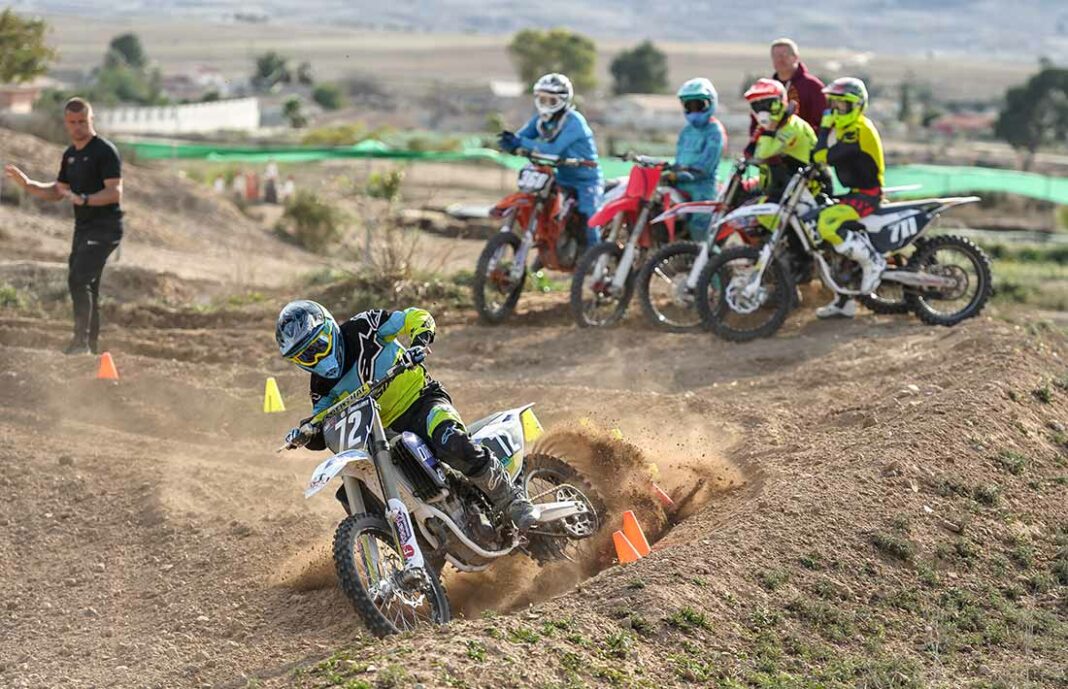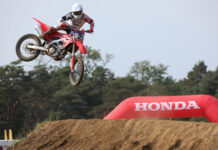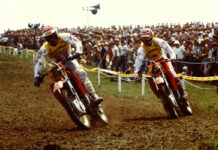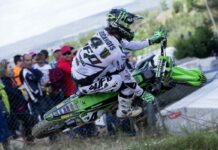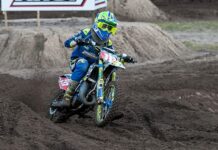With MX training becoming increasingly specialised, the RMJ Academy has hooked up with a team at Liverpool John Moores University to take research to the next level…
Motocross is a sport that demands fitness – mental as well as physical – and there’s a growing industry devoted to catering for a racer’s mind and body.
Up until now, certainly in the UK at least, there hasn’t been an exhaustive, in-depth, long-term academic study into what top-flight riders go through during the course of a season – but that’s all about to change.
A team at Liverpool John Moores University, in conjunction with the RMJ Academy, is devoting the next three years to studying the subject with 29-year-old sport nutrition expert Stephen Smith aiming to complete a PhD in motocross. Working alongside Stephen is Carl Langan-Evans, the university’s Sport Science Support Officer, whose fields of expertise include strength and conditioning, sport training and sport physiology.
Before you dismiss them as white-coated boffins with big foreheads I should point out that Stephen is a passionate road racer whose ultimate ambition is to compete in the TT and 30-year-old Carl’s a former taekwondo athlete who’s still heavily involved in the sport as a high-performance coach. Basically, they both talk the talk and walk the walk.
An afternoon touring the university’s facilities is an eye-opening experience. There are a lot of big words being bandied about but it’s genuinely fascinating stuff. This is just about as far removed as it gets from the old-school ‘run five miles, do some motos, drop and give me 20’ approach – this is cutting-edge, heavyweight science.
I’m going to attempt to explain what’s going on in layman’s terms but before we get into the nitty gritty of how the John Moores team is conducting its research here’s some background into how the study has come about along with its objectives.
Richard-Mike Jones needs little introduction to DBR readers. A racer turned trainer, he’s guided GP competitor Adam Sterry since he rode autos and now has a pro stable that includes some of the country’s brightest up-and-coming talents.
“The PhD study is a bit of a win-win for the RMJ Academy,” says Rich-Mike. “Short-term we get a lot of testing done and find out where the pro athletes are at with their fitness and strength and long-term we find out what the specific demands of motocross are.

“Everyone within motocross is quick to say it’s the hardest sport in the world but there’s never been any studies done on, for example, what the fatigue factor is on muscles. There’s never been evidence collected showing what’s the best way to prepare for motocross as there has been for other sports like football or marathon running.
“This is a big step for the RMJ Academy and also a big step for motocross.”
Rich-Mike originally approach LJMU for advice on nutrition but the project quickly snowballed.
“I met with a guy called Graeme Close who’s a nutritionist to the England rugby team. In that meeting Stephen was sat with him and he asked ‘how far do you want to go with this?’ and my reply was ‘as far as physically possible’.”
With a background in trials and enduro, Stephen – from nearby Speke – has a keen interest in two-wheeled motorsport but until now no involvement in motocross. With a Masters degree in sports nutrition already under his belt he was aiming to go on to do a PhD before he met Rich-Mike.
“Rich approached the uni and my supervisor suggested I should explain to him about the match-funded PhD options,” says Stephen. “The way this works is that the RMJ Academy puts in some money and the university matches it on the understanding that we get the opportunity to do research and Rich gets the opportunity to do testing and get support with his riders.
“Essentially the aim of the PhD is to investigate what goes on when these lads are riding the bike during training and competition and look at the physiology of motocross.
“We’ll have to do some sort of investigations and studies while they’re on the bike. This could be through simple heart-rate monitoring, blood markers, how much movement they do on the bike and how much time they spend on the bike or off the bike when they’re training.

“We have access to GPS accelerometers – these are basically vests that the lads will be wearing that have a sensor in them that measures how much movement they do, force, acceleration and how much distance they cover.”
Although there have been studies conducted into the demands of motocross these are few and far between. Fortunately, LJMU has a huge amount of experience in sports science research and the team will draw upon this.
“We’ve got a vast array of experience in non-mainstream sports at John Moores so we’ve worked with jockeys, we’ve looked at combat sports but we’ve also got experience working in elite sports. So we’re drawing on our knowledge from all these different areas and applying it to motocross.
“We’ll be able to compare what it takes to become an elite motocross rider to what it takes to become an elite jockey or an elite cyclist or an elite rugby player or an elite football player. What we’re trying to do is identify what adaptations or what characteristics make the elite riders stand out from the people who don’t make it in the sport.”
Nutrition and training practices will be formulated around the research with everything geared to optimising on-track performance.
“We’re trying to take motocross to that next level. From what I’ve seen people who already work in the sport rely on their own experience to inform what they do with other riders – what we’re trying to do is nail down the physiology of what goes on so we can actually use proven data to inform our practice.
“It’s just amazing, it’s my dream job. I’ve always been interested in motorbikes and I’ve always wanted to progress to PhD so when this opportunity came around I had to grab it. I’m pinching myself every day to make sure it’s real.”
For Carl the goal of the study is to develop “scientifically-informed practice” and with a list of academic qualifications to his name including a PhD in exercise physiology he’s an essential part of the team.
“I’m completely new to motocross and when I sat down with Rich and he said ‘look, this is the season’ I remember thinking ‘what the hell do you want me to do with that?’,” says Carl. “These guys ride every week – it’s like no sport I’ve ever seen in my entire life – and it will be really interesting for us to examine what is going on with these guys over a whole season.

“This is the first study of its kind in the UK and it’s going to get better all the time. What we do this year will pale in comparison to what we’ll do next year and the year after that.
“The whole programme is a completely individualised rider approach based around all the testing that we do and not just a blanket programme that every rider follows.”
By treating each rider on an individual basis, specific weaknesses and strengths can be identified which in turn will ensure programmes are tailor-made.
“A lot of this stuff is done in a lot of other sports. Probably the one we’ll measure it against the most will be cyclists mainly because their seasonal schedule is very similar – the nature of what they’re doing is pretty similar, particularly probably BMX cyclists.
“We wouldn’t be measuring our guys against them but particularly for a baseline we’d be using it as a comparative measure. Once we’ve got this data in year one, year two we’ve got something to measure against ourselves.
“People say that motocross is the toughest sport in the world but is it as tough as the Tour de France? We’ve got that data so let’s compare it and see if it is. That’s the beauty of doing this – it helps us assess the biochemical stress that’s going on.”

The technology available at LJMU is as good as it gets. Remember the training scene from Rocky IV when Ivan Drago’s every move is monitored and recorded? Well that’s the Hollywood version of what academy members get up to.
One of the tools at the team’s disposal is the Body Composition Assessment Suite.
“What we’re interested here is basically how is their body composition in terms of body fat, muscle and bone structure changing over time,” says Carl. “We’ve got the DXA [dual-energy x-ray absorptiometry] scanner which is a very low radiographic scanner so it’s like one-tenth of an x-ray.
“This gives us an output of a person’s bone health in different regions and a summary of fat mass, lean tissue mass and bone mass and we can track these over the season. This goes a huge, huge way to all the nutrition design.”
Deciding on what constitutes as ideal body composition for motocross won’t purely be based on science. The team will also look at the appearance of other top riders’, listen to Rich-Mike’s opinions and take the riders’ genetics – for instance are they naturally skinny – into account before making informed judgement calls.
Another tool is an environmental chamber that can replicate temperatures from Arctic to Saharan and altitudes from sea level to Himalayan.

“For example,” says Carl, “looking at Adam Sterry who’s going to going out the GPs in Qatar and Thailand. He’s going to be leaving here in winter, he’s not going to be heat acclimated so we’re going to do a load of work with him before he goes in all of his moto gear to get him acclimated. By the time he gets to the event he’ll be prepared and ready to perform.
“He’ll train in there and we’ll be playing around with things like hydration strategies and the potential use of ice vests for recovery between motos. A lot of it is mental acclimation – Adam going out for his first GP in Qatar and knowing that he’ll be used to the heat.”
The physiology lab collects samples taken from the riders including blood, sweat and urine which is then passed to the biochemistry lab for analysis.
“Specifically with the moto guys what me and Ste are really interested in is we want to look at how tough the season is on them biochemically,” continues Carl. “We’re looking at the potential to take some blood off them at the start of the season then mid-season and post-season and examine some markers of things like muscular fatigue and stress just to have a look at the metabolic damage. That will then help us assess next year where are the high and low points in a season, what physiologically is actually happening to these guys.
“As I said, everything we do is very individualised to the rider so we’ll be measuring things like creatine kinase, testosterone and cortisol – we’ll look at a baseline at the start of the season, mid-season and end-of-season and that will give us a better idea.”
Creatine kinase is a compound that’s a by-product of muscle breakdown and by measuring the levels in a motocross rider they can make a direct comparison against levels they’ve already discovered in athletes from other sports.

“We’ve got these different markers and we pretty much know how hard a lot of sports are, we don’t know how hard motocross is. That’s why we’re doing it and also that will then help us judge the programming and the way we interact with the riders throughout the season.
“It will help us feed into Rich and say ‘this guy’s markers are really high’ and put things into place whether they be nutrition, recovery, specific training interventions. It informs our programme.”
With so much data being collected I have to ask the question can they get too much information but Steve just laughs and says there’s no such thing. Basically, if something figures in a rider’s performance they want to know about it.
“Different track surfaces will have different effects on the riders’ bodies too so deep sand such as Lommel is a lot more demanding,” says Steve. “We need to look at the physiological differences – what makes it harder?
“With Adam doing GPs we’ve got the opportunity to look at what a truly elite rider needs to make it on the world stage. It gives us an idea of where the younger lads need to be to compete at that level.

“We also need to look at what the difference is between GP competition and national competition – whether that be how much travelling they do, how much bike time they have and what are the effects of a GP compared to a national round. Using the kit we have at John Moores we can do that.”
Adam’s GP campaign this season will provide valuable data that riders competing on a purely domestic level couldn’t provide.
“One of the other things I’m interested in is jetlag and travel fatigue because some of these guys are going to be travelling long distances,” says Carl. “There are a lot of strategies that we can try and put into place to try and limit that – nutrition and things like sleep patterns on flights, when to stay awake and when to go to sleep.
“We can even do some preparation before they go – it’s all about getting a rider to the startline as prepped as they possibly can be.”
Although the research is still in a very early stage the LJMU relationship with the RMJ Academy has already had positive results.
“Adam has had ongoing problems with his lower back on rougher circuits,” says Rich-Mike. “His technique on rougher tracks – how he works his legs to keep the bike moving – is really good so in my eyes he just needed to get more endurance in his legs.
“Carl has done mobility tests and found that his hip flexors were shocking so he’s given him exercises and he’s not having problems now on rough sand tracks. Had I not got these guys involved I would have gone the complete opposite way.”
The respect is mutual…
“Rich has been doing this for a long time and that’s his approach, we have a different approach and I think by having this we get the best of both worlds,” adds Carl. “There have been instances where we might have been a bit softly, softly and Rich has been bang on the money. It’s an eclectic mix and the key pay-off for me is the buy-in from the riders. They’re always there, they’re always putting the effort in, they’re always pushing. They believe in it.”

There’s an obvious question that needs an answer – what happens if the research leaks out? After all, it’s a big investment by the RMJ Academy. Surprisingly, Rich-Mike isn’t all that fussed.
“Maybe I should go down the route of making the findings private but part of me isn’t too bothered if people use it because it’s good for the sport,” he says. “The information we find will allow us to build better programmes – obviously, I don’t want my rivals having that information but if I’m not able to keep it private then at least it will take the sport to another level.”
Keeping the research private is one thing but what happens if a rider defects to another trainer?
“I can’t stop that but, apart from the PhD element, that’s kinda how it already is. Touch wood, as a rule people don’t leave me but if they do there’s no way of stopping that but at the same time I won’t hold back on what I give my riders.
“And if I give them everything I’ve got and do a good job then they won’t go off. That’s how I look at it.”

Vascular assessment – An end to arm-pump?
“One thing we haven’t really assessed yet – we’ll probably address it when we get into the season – is the dreaded arm-pump,” says Carl. “This is a vascular problem where basically your not getting the flow through the forearm purely because you’re gripping the bike.
“There are strategies and training implementations and nutritional implementations that we’re going to put in place to try and limit that. I do a lot of forearm work in my training programme and I think the guys already are not as worried anymore based around the strength work that they’re doing.
“If it happens then there are things we’re going to try and work on – there are nutritional things that I’m not going to let on about that we can do.”

Neuroscience – The brain game
“With neuroscience what we’re looking at is the link between the cognitive element of performance and the physiology and the biomechanics,” says Carl. “So we use things like the eye-trackers, psychological programmes – basically brain training, working on reaction times, response times, things like that.”
Biomechanics – Feel the force
“Everything we do in the institute has a performance angle and a clinical angle,” says Carl. “We work with sport and exercise and health basically so with the biomechanics we’re interested in the joints, angles, forces during sporting events that transfer through the body. It’s the study of human movement.
“Just landing off a box on your own two feet can transfer anywhere up to two to four times your bodyweight. I would hypothesise that obviously with the moto guys with them travelling through the air and then landing it could be even more, even with suspension.
“With the snowboarders we were looking at the impact because they tend to get a hell of a lot of ACL injuries, knee, ankle, hip injuries.
“The problem with doing it with the moto guys specifically is that we can’t drop a 100 kilo bike on top of the force plate from 30 feet but we can get a decent idea by doing a couple of other things.”



